Over the past few years, an unprecedented number of consumers have switched brands or retailers, and nearly 80% of consumers plan to continue exploring their options moving forward.
With customer loyalty at an all-time low, competition is steeper than ever. To thrive in today’s crowded ecommerce environment, brands must have a deep understanding of their target customer, and how well they are meeting their needs.
Fortunately, reviews – when analyzed in the appropriate manner – contain a lot of the information you need to understand and improve your products. Here are the seven top insights you can glean:
1. Discover how customers feel about your products
Let’s start with the most obvious benefit: understanding how your customers feel about your products. You can see the top words and phrases customers use when describing your product, and the associated sentiment. This information is crucial for understanding the voice of your consumer (which has applications throughout your marketing efforts). It can also help you discover the quirks of your products that create positive sentiment.
For example, we can see that adjectives like comfortable and versatile are highly associated with positive sentiment for this hypothetical shoe. While words like durable and casual also tend to have positive sentiment, those words also appear in reviews with negative sentiment — suggesting perhaps that consumers may disagree on whether the shoe really is durable, or some may view the casual style as a positive while others view it as a negative.
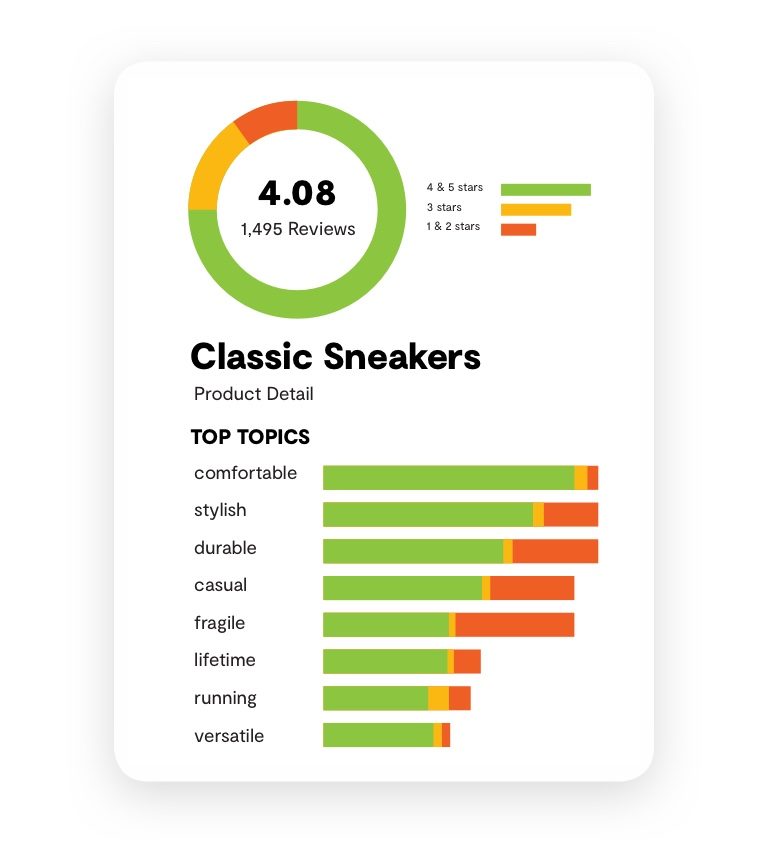
2. Hone in on the right keywords for SEO and Google advertising
Knowing the words your consumers use can also help you reach them more effectively in the search results. Are you targeting the right keywords in Google Ads, based on how your customers search for products like yours? Does your product description tell the best story for SEO? Product Sentiment Analytics can help you find out.
In the example below, we see that customers positively refer to a product as a dog treat, chew, supplement and vitamin, even though the product itself may be described as a supplement. By adding those additional descriptors into the product description — and targeting them in Google Ads — the brand can reach more potential customers.
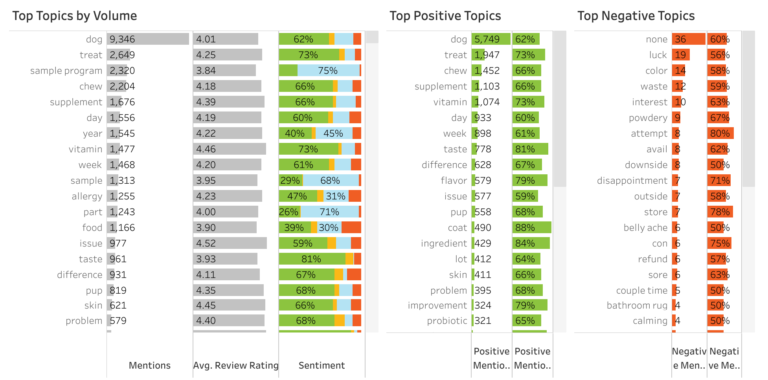
3. Highlight the products and features your customers like most
In addition to boosting your SEO efforts, review content can point you toward key features you should highlight throughout your marketing.
For example, take the review below. If phrases like “arch support” and “treadmill” frequently show up in rave reviews for a pair of shoes, it may be worth incorporating those benefits in your marketing for that product, such as showing a person running on a treadmill in a Facebook post or a YouTube ad.
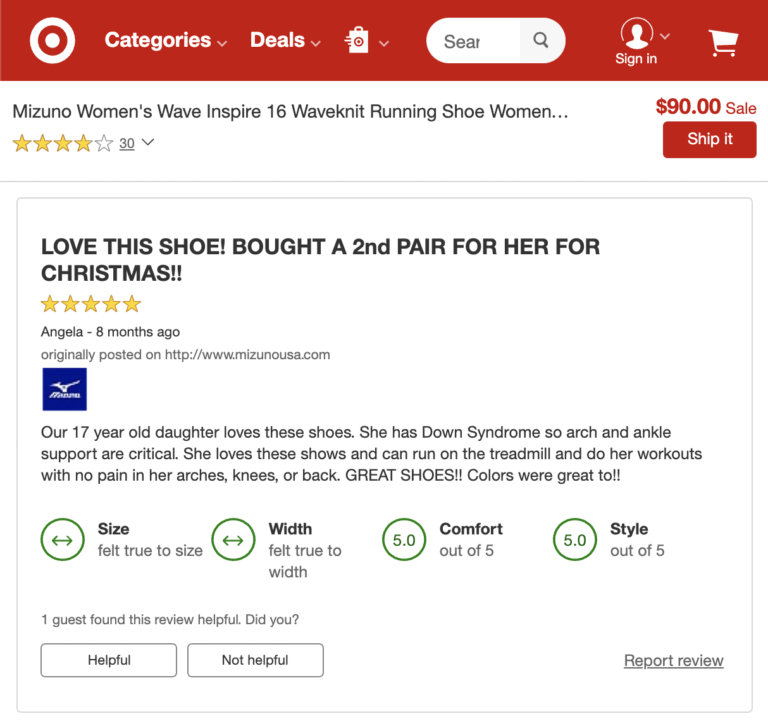
Need more inspiration for how to promote a particular feature customers love about your products? Our Product Sentiment Analytics tool lets you dig even deeper. In the example below, customers generally speak positively about the product’s material.
By clicking on the word material, you can see the top descriptors associated with that word. This product has a flattering fit and makes people feel great and beautiful. Those are great points to include in your product description and marketing!
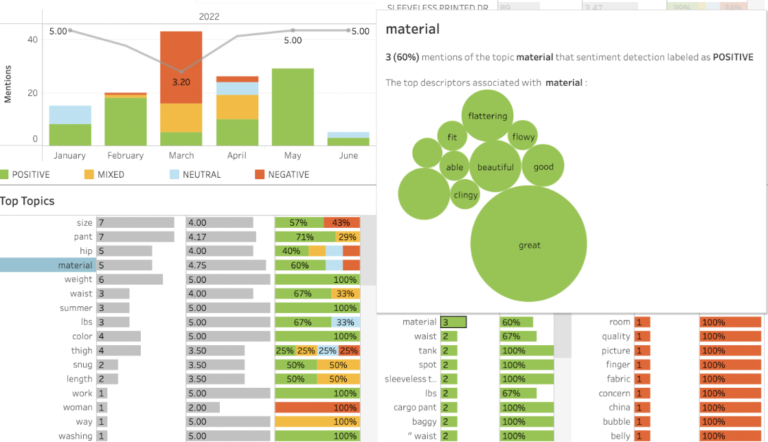
4. Use top descriptors to focus on your next product innovation
Reviews can be treasure troves of product feedback. Mine them, and you’ll find ideas to spark your next product enhancement.
Going back to our dog treats example, it looks like some consumers have issues with the color and the powdery texture. Those are two insights you can take back to the product development team to see if version 2.0 of the dog treats can better meet your customers’ needs.

5. Identify and resolve issues before they get worse
Speaking of customer complaints, negative sentiment can be a veritable “canary in the coal mine” for your brand. A good start: tracking changes in sentiment over time. If you notice dips in sentiment or an increase in negative sentiment, look into it. Did something change with your manufacturing process?
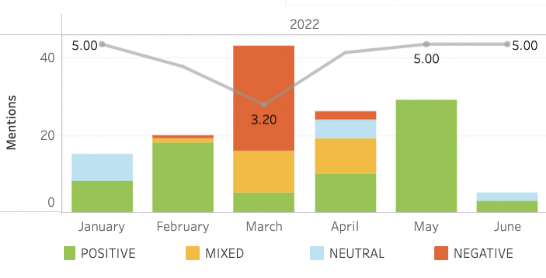
Are sales for an item lower than expected? It’s possible your customers found a flaw that needs to be addressed. Take a look at the top descriptors associated with negative sentiment to hone in on the issue.
By the same token, you can also use this report to see if sentiment improves after you’ve implemented a product improvement.
6. Launch new products with success
There’s always a bit of guesswork involved when it comes to marketing a new product. Sure, it’s educated guesswork, likely based on user research or what you know works for similar products. But still, you don’t know 100% how a new product will resonate with consumers.
Sampling campaigns are a commonly used tactic to boost review volumes and gain consumer buy-in to new products. Measuring the sentiment of these reviews enables you to adjust your go-to-market strategy to make the subsequent launch more successful, answering questions like:
- What are our customers’ favorite features about this product?
- What words and phrases should we use when talking about this product?
- Are there any issues we should fix before launching the product nationwide?
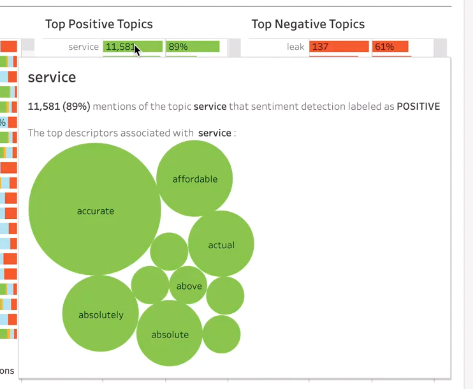
7. Compare sentiment across products, categories, and brands
Also use review data to compare and contrast customer sentiment across your various brands, categories, and products.
Let’s say your company sells tires. Your newest tire, Product D, seems to be struggling but you’re not sure why. So, you compare it against three of your best-selling tires. In your Product Sentiment Analytics, you notice that Product D has more negative sentiment around experience than your other tire products.
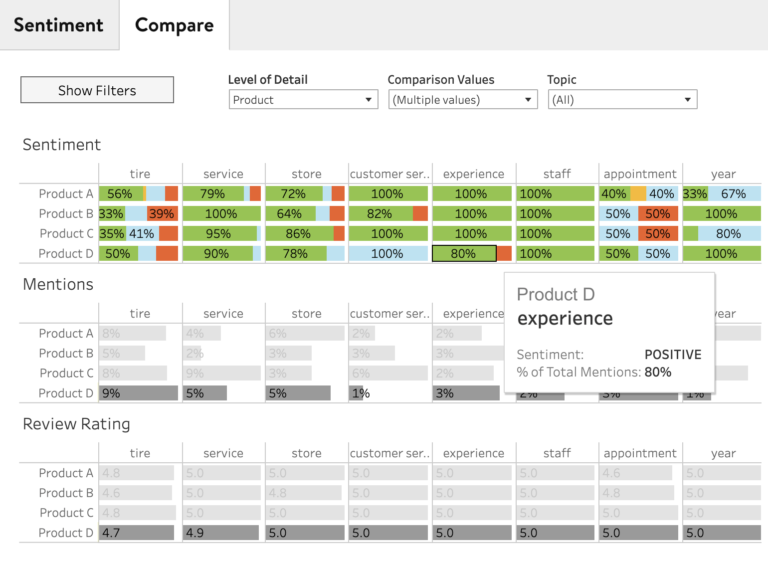
This may signal an area where you may need to make a change. You can investigate further to see whether the reviews that mention a negative experience with Product D are talking about your customer service, the installation experience, or an experience driving out on the road — and make improvements accordingly.
Improve product performance with Product Sentiment Analytics
Think this insight might be helpful? Product Sentiment Analytics can help you tap into the voice of your customers, optimize your product marketing strategy, and make product improvements that benefit not only your ratings and reviews program, but your bottom line.
If you’re a current PowerReviews customer, great news: you can access all of these metrics in your reporting for free. Not yet a PowerReviews customer? Learn how we can help you do more with UGC.





